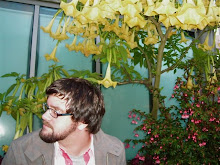Before my friend Doug and I got rolling on the Organic Chair in November, most of my attention was concentrated on further exploring the repetitive, geometric technique I developed while working on my
"Ark" chair. The two tables shown below are inspired by the recent transitions to Fall and Winter, respectively, and both follow the same symmetrical, 45-degree angle model. However, with these pieces, I concentrated on the star pattern that naturally emerges when using triangular-shaped pieces.


The tops of both these pieces might be the first thing that catches peoples' eyes, and I'm happy the fabrication of each worked out as well as it did with the number of variables presented with using so many pieces for each. They were somewhat tedious and time consuming to put together, but the base and legs for each proved much more challenging to put together. I should quickly mention that the fabrication process for the tops of each are not "inlay" as several people have commented. They're not stained either; the colors you see are the natural colors of the woods (mostly walnut, paduak, canarywood and redheart), with only a topcoat of semi-gloss polyurethane. Inlay involves insetting thin, non-geometric (marquetry) or geometric (parquetry) shapes into another surface. These star tables are made by putting together hundreds of individual diamond-shaped pieces.
But back to the base and legs. These were more challenging - particularly the curvy orange (made of paduak) and yellow (made of canarywood) turned ones.


In the picture on the right side, you might be able to see a curved cut mark near the foot of each one. These wrap around each leg, again in a pattern, and were partly the result of an accident. I'm not sure if this is a common occurance of more seasoned woodturners, but I often get a lot of splintering near the top and bottom of my stock. In an attempt to combat this, I started off by cutting a 45-degree angle around the stock near the top, thinking this would preempt any splintering that normally occurs. As I was turning the area around the cut, I noticed a rounded, petal-like form emerging. This did fix my splintering problem, but also resulted in an innovative form that further highlights the botanical spirit of the whole piece.
Next up, I'm going to try to make a massive form using this pattern technique. My dad, who is much better than I am with math, reminded me that the angle of cut of the triangular/diamond shaped pieces would determine the number of points on similarly star-shaped fabrications: 60-degrees = 6-sided; 45-degrees = 8-sided; 30-degrees = 12-sided; etc. So next up, I'm tackling a project that will use a combination of 60- & 30-degree pieces. But this time, I want to make something that has a rounded or wavy top surface. Any fellow woodworkers, artists, designers or math whizzes out there who can help?
 My friend Doug, from dKiser design.construct, and I finished a collaborative project for Bluestone Development's new office this past weekend. Bluestone's new space is located at 13th & Webster, in the same location that was formerly the Empty Room. After finishing our ORGANISM installation, the fine folks of Bluestone asked us to create a unique installation for their newly added south wall to add some additional character and warmth to the space. Doug and I brainstormed some ideas and came up with a shared vision that would utilize lots of separate wooden panels of different sizes, shapes, depths and tones.
My friend Doug, from dKiser design.construct, and I finished a collaborative project for Bluestone Development's new office this past weekend. Bluestone's new space is located at 13th & Webster, in the same location that was formerly the Empty Room. After finishing our ORGANISM installation, the fine folks of Bluestone asked us to create a unique installation for their newly added south wall to add some additional character and warmth to the space. Doug and I brainstormed some ideas and came up with a shared vision that would utilize lots of separate wooden panels of different sizes, shapes, depths and tones. 














